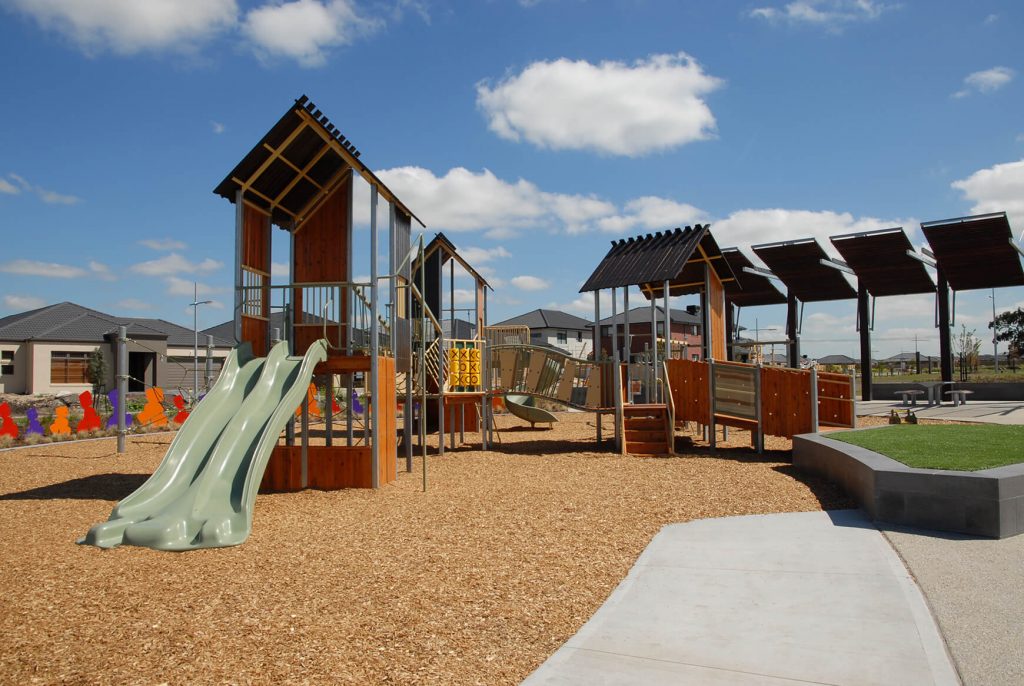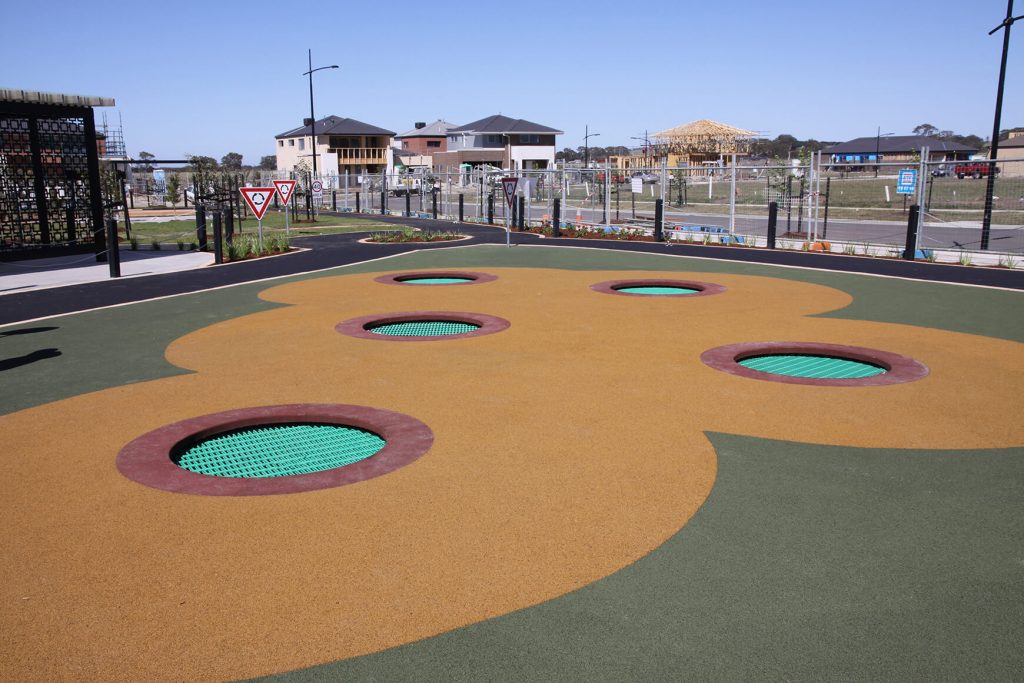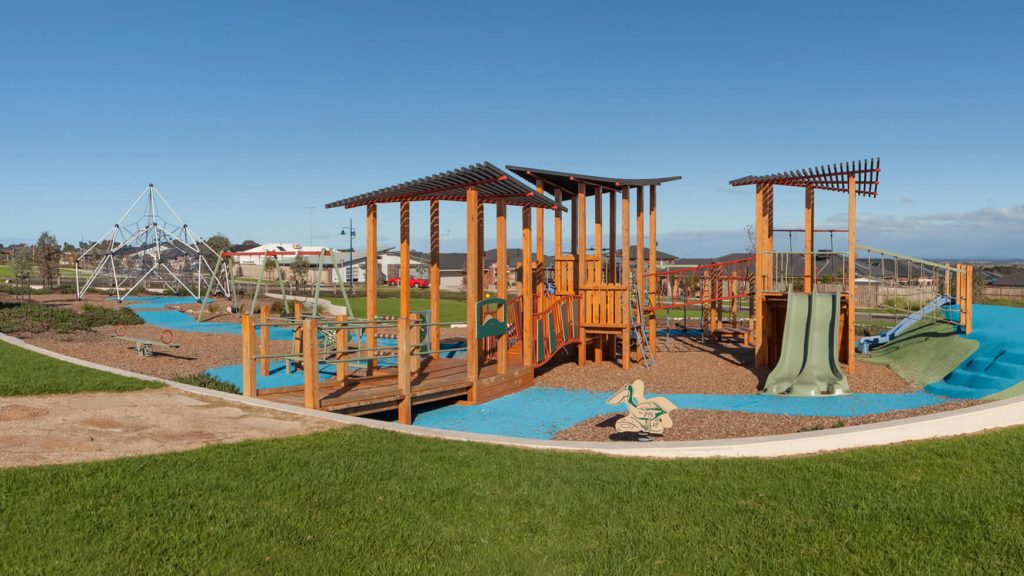Product added to your enquiry
Pros & Cons of Playground Undersurfacing
Playground Planning & Design Tips
10 Mar 2016
Playground undersurfacing is an integral part of a safe play space and it is an important element in play space planning and design.
Impact-absorbing material must be used under play equipment with fall heights greater than 600 millimetres above ground level, and needs to extend to the extremities of the impact areas around the equipment. Australian Standard 4685:2014 provides specific guidance on both fall zones and fall attenuation requirements, and a detailed knowledge of this standard is required when constructing or maintaining a play space.
Almost all playgrounds are required to have some type of undersurfacing. The most common playground surfacings include: loose organic materials such as mulch, woodchip or bark, loose non-organic materials such as sand or pea gravel, rubber, synthetic grass or a combination of these.
The Australian Standard defines appropriate fall attenuation testing methods, and any of the materials listed should be tested to determine the appropriate thickness of material required for the relevant fall height.
Loose Organic Materials: Mulch/Bark
Loose organic material such as wood mulch is one of the most common undersurfacing materials, especially in small pocket parks. Compared to other types of undersurfacing, mulch has a relatively inexpensive initial capital cost due to its availability. While many suppliers stock a range of mulches, it is vital to specify playground mulch which has been tested in accordance with the standard and for which compliance certification, or a test certificate is available. Not all types are suitable for playground areas, and material that produces sharp splinters should be avoided.
Installing mulch is easy and does not require special expertise or machinery in small areas. For large areas, mulch can be blown direct from truck to play area, or placed by Bobcat or mini-loader and raked out to an even depth. Typically mulch is installed to a depth of 250 to 300 millimetres, depending on the fall height and supplier’s specifications.

While mulch is effective if installed correctly, it has pit falls that need to be considered. Loose materials can easily be displaced through rain, wind or children playing, so needs to be checked constantly, wear patches routinely raked, and it also needs to be replenished regularly. So while relatively economical initially, mulches are somewhat more expensive to maintain than some other surfaces.
It is to be noted that impact absorption can be reduced if the mulch is too shallow, wet or combined with other materials, and it can also harbour debris such as broken glass or syringes.
Pram or wheelchair traffic is difficult on loose materials, so for all-ability playgrounds rubber paths can be installed throughout the play area, or alternative types of undersurfacing may need to be considered.
Non-Organic Loose Materials: Sand
Sand is utilised as an undersurfacing throughout Australia, but particularly for playgrounds in Western Australia.
Sand carries with it many advantages similar to mulch in that it is relatively inexpensive and can be easily obtained from local landscape suppliers. Clayey or brick sand is generally too dirty to be suitable and washed or river sands perform the best. In contrast to mulch, the material itself becomes another play element in the space that small children or toddlers love! However, sand requires maintenance, including checking, raking and replenishing regularly and it is particularly prone to concealing unsafe objects beneath the surface.
In some areas, animal soiling can be a real health issue and dirt, water or mud can negatively affect impact attenuation.

Rubber
Rubber undersurfacing is often specified by Landscape Architects in high profile play spaces because of its visual impact through the variety of colours and patterns available, as well as its serviceability. Although the initial expense is high, it is very durable and requires little maintenance, meaning it relatively cost efficient over the life of the playground compared to loose materials such as sand or mulch.
Installed on a base of concrete or compacted roadbase material, the rubber is either in tile form of different thicknesses to suit different fall heights, or wet poured in-situ with a coarse fall attenuation layer, topped with a coloured wear layer.
The material consists of rubber granules or shredded tyre rubber in a flexible synthetic binder. The use of recycled tyres provides an important environmental contribution to the reduction of land fill, although manufactured granules are sometimes specified because of their superior colour retention.
While rubber is a firm surface, excellent for all abilities access and prams, it is also water-permeable meaning no puddles and wet kids! It can have inset shapes such as animals or other themed features (including three-dimensional sculptures), and can provide added play opportunities with hop-scotch markings or other games. Due to its long lasting qualities it is often used on mounds to prevent erosion and can be moulded into steps for easy access. (Read more on designing with slopes )

Synthetic Grass
Similar to rubber undersurfacing this is a relatively expensive material. Synthetic grass still requires a certified impact absorbing surface beneath meaning costs are compounded. However, this is often used because of it is natural look, pleasing aesthetics and can be joined seamlessly with other play areas such as ovals or ball courts. Obviously it is wheelchair trafficable so is a great choice for an all-abilities playground, and its relatively low maintenance tends to balance the initial cost.
Combination of Materials
A balance between aesthetic, cost and performance criteria can be successfully achieved by using a combination of the above materials.
At the most basic level, rubber wear pads are often installed in mulch or sand surfaces under swings, at the end of slides and in other high wear areas.
To make a play area all-abilities accessible and cover slopes or high traffic areas, rubber paths are often interweaved throughout mulch or sand areas also. Not only is this a cost effective method compared to getting a whole area rubberised, it also looks great and makes the area feel more adventurous!
Furthermore, where the play space layout will benefit from directed traffic flow, rubberised paths achieve this successfully while still maintaining appropriate fall attenuation properties.

While aesthetic and cost considerations are sometimes uppermost in a playground designer’s mind, we must remember that the most important purpose of installing undersurfacing is that it is a critical element of a safe playground!
For a play space to be standards compliant, careful consideration needs to be given to assessing the fall heights and impact area requirements of each individual component, and ensuring that the undersurfacing when tested in accordance with the standard, provides an appropriate level of fall attenuation.
All the materials mentioned above can be utilised and combined in various ways to create interesting and engaging play spaces while fulfilling the primary purpose for which they are designed.
adventure+ has been designing, manufacturing and installing unique playground equipment for over 30 years. We are available to provide specialised design, playground advice and industry insights.